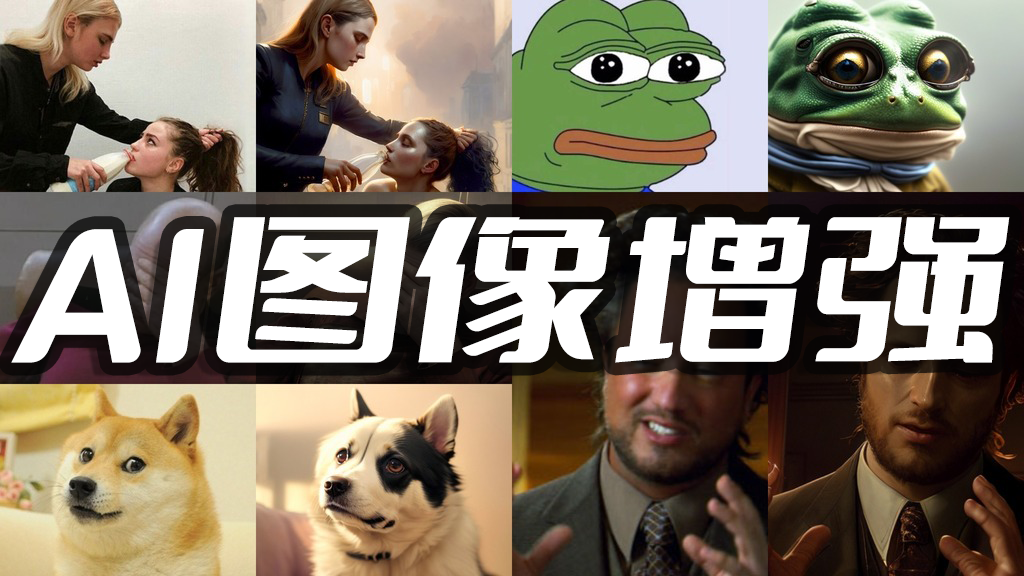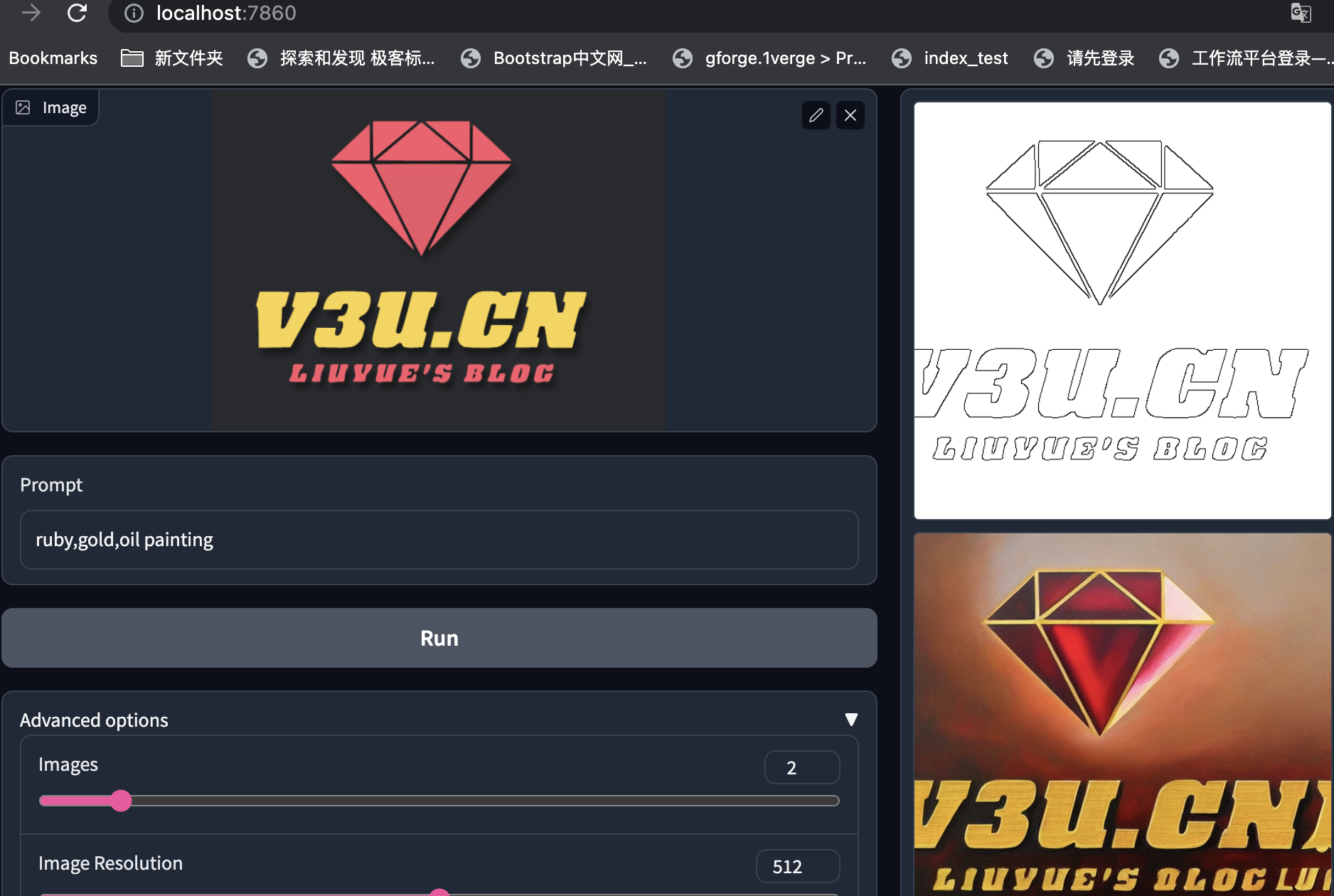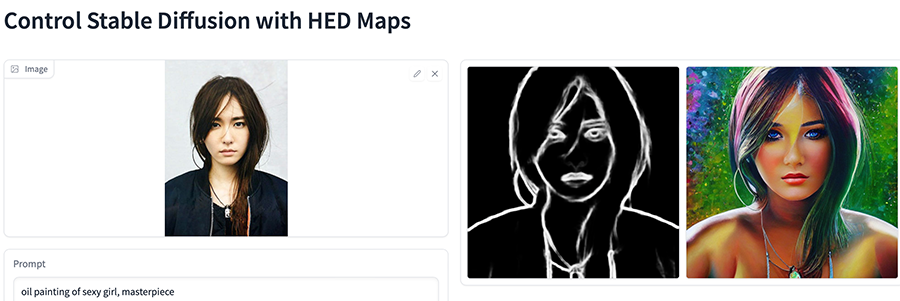

登峰造极,师出造化,Pytorch人工智能AI图像增强框架ControlNet绘画实践,基于Python3.10
source link: https://v3u.cn/a_id_282
Go to the source link to view the article. You can view the picture content, updated content and better typesetting reading experience. If the link is broken, please click the button below to view the snapshot at that time.


人工智能太疯狂,传统劳动力和内容创作平台被AI枪毙,弃尸尘埃。并非空穴来风,也不是危言耸听,人工智能AI图像增强框架ControlNet正在疯狂地改写绘画艺术的发展进程,你问我绘画行业未来的样子?我只好指着ControlNet的方向。本次我们在M1/M2芯片的Mac系统下,体验人工智能登峰造极的绘画艺术。
本地安装和配置ControlNet
ControlNet在HuggingFace训练平台上也有体验版,请参见: https://huggingface.co/spaces/hysts/ControlNet,但由于公共平台算力有限,同时输入参数也受到平台的限制,一次只能训练一张图片,不能让人开怀畅饮。
为了能和史上最伟大的图像增强框架ControlNet一亲芳泽,我们选择本地搭建ControlNet环境,首先运行Git命令拉取官方的线上代码:
git clone https://github.com/lllyasviel/ControlNet.git拉取成功后,进入项目目录:
cd ControlNet由于Github对文件大小有限制,所以ControlNet的训练模型只能单独下载,模型都放在HuggingFace平台上:https://huggingface.co/lllyasviel/ControlNet/tree/main/models,需要注意的是,每个模型的体积都非常巨大,达到了5.71G,令人乍舌。
下载好模型后,需要将其放到ControlNet的models目录中:
├── models
│ ├── cldm_v15.yaml
│ ├── cldm_v21.yaml
│ └── control_sd15_canny.pth这里笔者下载了control_sd15_canny.pth模型,即放入models目录中,其他模型也是一样。
随后安装运行环境,官方推荐使用conda虚拟环境,安装好conda后,运行命令激活虚拟环境即可:
conda env create -f environment.yaml
conda activate control但笔者查看了官方的environment.yaml配置文件:
name: control
channels:
- pytorch
- defaults
dependencies:
- python=3.8.5
- pip=20.3
- cudatoolkit=11.3
- pytorch=1.12.1
- torchvision=0.13.1
- numpy=1.23.1
- pip:
- gradio==3.16.2
- albumentations==1.3.0
- opencv-contrib-python==4.3.0.36
- imageio==2.9.0
- imageio-ffmpeg==0.4.2
- pytorch-lightning==1.5.0
- omegaconf==2.1.1
- test-tube>=0.7.5
- streamlit==1.12.1
- einops==0.3.0
- transformers==4.19.2
- webdataset==0.2.5
- kornia==0.6
- open_clip_torch==2.0.2
- invisible-watermark>=0.1.5
- streamlit-drawable-canvas==0.8.0
- torchmetrics==0.6.0
- timm==0.6.12
- addict==2.4.0
- yapf==0.32.0
- prettytable==3.6.0
- safetensors==0.2.7
- basicsr==1.4.2一望而知,Python版本是老旧的3.8,Torch版本1.12并不支持Mac独有的Mps训练模式。
同时,Conda环境也有一些缺点:
环境隔离可能会导致一些问题。虽然虚拟环境允许您管理软件包的版本和依赖关系,但有时也可能导致环境冲突和奇怪的错误。
Conda环境可以占用大量磁盘空间。每个环境都需要独立的软件包副本和依赖项。如果需要创建多个环境,这可能会导致磁盘空间不足的问题。
软件包可用性和兼容性也可能是一个问题。Conda环境可能不包含某些软件包或库,或者可能不支持特定操作系统或硬件架构。
在某些情况下,Conda环境的创建和管理可能会变得复杂和耗时。如果需要管理多个环境,并且需要在这些环境之间频繁切换,这可能会变得困难。
所以我们也可以用最新版的Python3.10来构建ControlNet训练环境,编写requirements.txt文件:
pytorch==1.13.0
gradio==3.16.2
albumentations==1.3.0
opencv-contrib-python==4.3.0.36
imageio==2.9.0
imageio-ffmpeg==0.4.2
pytorch-lightning==1.5.0
omegaconf==2.1.1
test-tube>=0.7.5
streamlit==1.12.1
einops==0.3.0
transformers==4.19.2
webdataset==0.2.5
kornia==0.6
open_clip_torch==2.0.2
invisible-watermark>=0.1.5
streamlit-drawable-canvas==0.8.0
torchmetrics==0.6.0
timm==0.6.12
addict==2.4.0
yapf==0.32.0
prettytable==3.6.0
safetensors==0.2.7
basicsr==1.4.2随后,运行命令:
pip3 install -r requirements.txt至此,基于Python3.10来构建ControlNet训练环境就完成了,关于Python3.10的安装,请移玉步至:一网成擒全端涵盖,在不同架构(Intel x86/Apple m1 silicon)不同开发平台(Win10/Win11/Mac/Ubuntu)上安装配置Python3.10开发环境,这里不再赘述。
修改训练模式(Cuda/Cpu/Mps)
ControlNet的代码中将训练模式写死为Cuda,CUDA是NVIDIA开发的一个并行计算平台和编程模型,因此不支持NVIDIA GPU的系统将无法运行CUDA训练模式。
除此之外,其他不支持CUDA训练模式的系统可能包括:
没有安装NVIDIA GPU驱动程序的系统
没有安装CUDA工具包的系统
使用的NVIDIA GPU不支持CUDA(较旧的GPU型号可能不支持CUDA)
没有足够的GPU显存来运行CUDA训练模式(尤其是在训练大型深度神经网络时需要大量显存)
需要注意的是,即使系统支持CUDA,也需要确保所使用的机器学习框架支持CUDA,否则无法使用CUDA进行训练。
我们可以修改代码将训练模式改为Mac支持的Mps,请参见:闻其声而知雅意,M1 Mac基于PyTorch(mps/cpu/cuda)的人工智能AI本地语音识别库Whisper(Python3.10),这里不再赘述。
如果代码运行过程中,报下面的错误:
RuntimeError: Attempting to deserialize object on a CUDA device but torch.cuda.is_available() is False. If you are running on a CPU-only machine, please use torch.load with map_location=torch.device('cpu') to map your storages to the CPU.说明当前系统不支持cuda模型,需要修改几个地方,以项目中的gradio_canny2image.py为例子,需要将gradio_canny2image.py文件中的cuda替换为cpu,同时修改/ControlNet/ldm/modules/encoders/modules.py文件,将cuda替换为cpu,修改/ControlNet/cldm/ddim_hacked.py文件,将cuda替换为cpu。至此,训练模式就改成cpu了。
修改完代码后,直接在终端运行gradio_canny2image.py文件:
python3 gradio_canny2image.py程序返回:
➜ ControlNet git:(main) ✗ /opt/homebrew/bin/python3.10 "/Users/liuyue/wodfan/work/ControlNet/gradio_cann
y2image.py"
logging improved.
No module 'xformers'. Proceeding without it.
/opt/homebrew/lib/python3.10/site-packages/pytorch_lightning/utilities/distributed.py:258: LightningDeprecationWarning: `pytorch_lightning.utilities.distributed.rank_zero_only` has been deprecated in v1.8.1 and will be removed in v2.0.0. You can import it from `pytorch_lightning.utilities` instead.
rank_zero_deprecation(
ControlLDM: Running in eps-prediction mode
DiffusionWrapper has 859.52 M params.
making attention of type 'vanilla' with 512 in_channels
Working with z of shape (1, 4, 32, 32) = 4096 dimensions.
making attention of type 'vanilla' with 512 in_channels
Loaded model config from [./models/cldm_v15.yaml]
Loaded state_dict from [./models/control_sd15_canny.pth]
Running on local URL: http://0.0.0.0:7860
To create a public link, set `share=True` in `launch()`.此时,在本地系统的7860端口上会运行ControlNet的Web客户端服务。
访问 http://localhost:7860,就可以直接上传图片进行训练了。
这里以本站的Logo图片为例子:

通过输入引导词和其他训练参数,就可以对现有图片进行扩散模型的增强处理,这里的引导词的意思是:红宝石、黄金、油画。训练结果可谓是言有尽而意无穷了。
除了主引导词,系统默认会添加一些辅助引导词,比如要求图像品质的best quality, extremely detailed等等,完整代码:
from share import *
import config
import cv2
import einops
import gradio as gr
import numpy as np
import torch
import random
from pytorch_lightning import seed_everything
from annotator.util import resize_image, HWC3
from annotator.canny import CannyDetector
from cldm.model import create_model, load_state_dict
from cldm.ddim_hacked import DDIMSampler
apply_canny = CannyDetector()
model = create_model('./models/cldm_v15.yaml').cpu()
model.load_state_dict(load_state_dict('./models/control_sd15_canny.pth', location='cpu'))
model = model.cpu()
ddim_sampler = DDIMSampler(model)
def process(input_image, prompt, a_prompt, n_prompt, num_samples, image_resolution, ddim_steps, guess_mode, strength, scale, seed, eta, low_threshold, high_threshold):
with torch.no_grad():
img = resize_image(HWC3(input_image), image_resolution)
H, W, C = img.shape
detected_map = apply_canny(img, low_threshold, high_threshold)
detected_map = HWC3(detected_map)
control = torch.from_numpy(detected_map.copy()).float().cpu() / 255.0
control = torch.stack([control for _ in range(num_samples)], dim=0)
control = einops.rearrange(control, 'b h w c -> b c h w').clone()
if seed == -1:
seed = random.randint(0, 65535)
seed_everything(seed)
if config.save_memory:
model.low_vram_shift(is_diffusing=False)
cond = {"c_concat": [control], "c_crossattn": [model.get_learned_conditioning([prompt + ', ' + a_prompt] * num_samples)]}
un_cond = {"c_concat": None if guess_mode else [control], "c_crossattn": [model.get_learned_conditioning([n_prompt] * num_samples)]}
shape = (4, H // 8, W // 8)
if config.save_memory:
model.low_vram_shift(is_diffusing=True)
model.control_scales = [strength * (0.825 ** float(12 - i)) for i in range(13)] if guess_mode else ([strength] * 13) # Magic number. IDK why. Perhaps because 0.825**12<0.01 but 0.826**12>0.01
samples, intermediates = ddim_sampler.sample(ddim_steps, num_samples,
shape, cond, verbose=False, eta=eta,
unconditional_guidance_scale=scale,
unconditional_conditioning=un_cond)
if config.save_memory:
model.low_vram_shift(is_diffusing=False)
x_samples = model.decode_first_stage(samples)
x_samples = (einops.rearrange(x_samples, 'b c h w -> b h w c') * 127.5 + 127.5).cpu().numpy().clip(0, 255).astype(np.uint8)
results = [x_samples[i] for i in range(num_samples)]
return [255 - detected_map] + results
block = gr.Blocks().queue()
with block:
with gr.Row():
gr.Markdown("## Control Stable Diffusion with Canny Edge Maps")
with gr.Row():
with gr.Column():
input_image = gr.Image(source='upload', type="numpy")
prompt = gr.Textbox(label="Prompt")
run_button = gr.Button(label="Run")
with gr.Accordion("Advanced options", open=False):
num_samples = gr.Slider(label="Images", minimum=1, maximum=12, value=1, step=1)
image_resolution = gr.Slider(label="Image Resolution", minimum=256, maximum=768, value=512, step=64)
strength = gr.Slider(label="Control Strength", minimum=0.0, maximum=2.0, value=1.0, step=0.01)
guess_mode = gr.Checkbox(label='Guess Mode', value=False)
low_threshold = gr.Slider(label="Canny low threshold", minimum=1, maximum=255, value=100, step=1)
high_threshold = gr.Slider(label="Canny high threshold", minimum=1, maximum=255, value=200, step=1)
ddim_steps = gr.Slider(label="Steps", minimum=1, maximum=100, value=20, step=1)
scale = gr.Slider(label="Guidance Scale", minimum=0.1, maximum=30.0, value=9.0, step=0.1)
seed = gr.Slider(label="Seed", minimum=-1, maximum=2147483647, step=1, randomize=True)
eta = gr.Number(label="eta (DDIM)", value=0.0)
a_prompt = gr.Textbox(label="Added Prompt", value='best quality, extremely detailed')
n_prompt = gr.Textbox(label="Negative Prompt",
value='longbody, lowres, bad anatomy, bad hands, missing fingers, extra digit, fewer digits, cropped, worst quality, low quality')
with gr.Column():
result_gallery = gr.Gallery(label='Output', show_label=False, elem_id="gallery").style(grid=2, height='auto')
ips = [input_image, prompt, a_prompt, n_prompt, num_samples, image_resolution, ddim_steps, guess_mode, strength, scale, seed, eta, low_threshold, high_threshold]
run_button.click(fn=process, inputs=ips, outputs=[result_gallery])
block.launch(server_name='0.0.0.0')其他的模型,比如gradio_hed2image.py,它可以保留输入图像中的许多细节,适合图像的重新着色和样式化的场景:

还记得AnimeGANv2模型吗:神工鬼斧惟肖惟妙,M1 mac系统深度学习框架Pytorch的二次元动漫动画风格迁移滤镜AnimeGANv2+Ffmpeg(图片+视频)快速实践,之前还只能通过统一模型滤镜进行转化,现在只要修改引导词,我们就可以肆意地变化出不同的滤镜,人工智能技术的发展,就像发情的海,汹涌澎湃。
“人类嘛时候会被人工智能替代呀?”
“就是现在!就在今天!”

就算是达芬奇还魂,齐白石再生,他们也会被现今的人工智能AI技术所震撼,纵横恣肆的笔墨,抑扬变化的形态,左右跌宕的心气,焕然飞动的神采!历史长河中这一刻,大千世界里这一处,让我们变得疯狂!
最后奉上修改后的基于Python3.10的Cpu训练版本的ControlNet,与众亲同飨:https://github.com/zcxey2911/ControlNet_py3.10_cpu_NoConda
Recommend
About Joyk
Aggregate valuable and interesting links.
Joyk means Joy of geeK